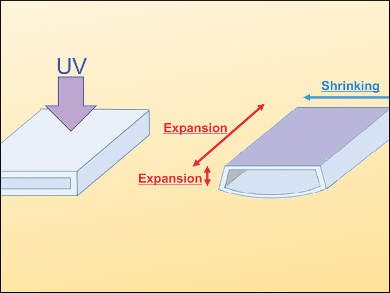Plants adopt unique strategies to increase their chances of successful reproduction. Impatiens, for example, can scatter their seeds over a certain distance when their seedpods explode.
Masakazu Morimoto, Rikkyo University, Tokyo, Japan, Kingo Uchida, Ryukoku University, Otsu, Japan, and colleagues have fabricated photoresponsive biomimetic materials by using photochromic diarylethene derivatives. Inspired by the scattering mechanism of Impatiens, the resulting hollow crystals can scatter their cargo.
Diarylethenes are organic photochromic molecules, and crystals of some compounds show photoinduced bending upon UV irradiation (pictured). The researchers prepared a new photochromic compound and were surprised to find that it formed hollow crystals upon sublimation. These crystals broke up and scattered into small pieces upon UV irradiation. This behavior arises from the large geometrical changes in the molecules during the reaction.
The researchers filled a hollow crystal with fluorescent beads (1.0 µm in diameter) and irradiated the sample with UV light. The crystals broke and the beads scattered. This concept may be applicable to phototriggered delivery systems.
- Photosalient Phenomena that Mimic Impatiens Are Observed in Hollow Crystals of Diarylethene with a Perfluorocyclohexene Ring,
Eri Hatano, Masakazu Morimoto, Takahito Imai, Kengo Hyodo, Ayako Fujimoto, Ryo Nishimura, Akiko Sekine, Nobuhiro Yasuda, Satoshi Yokojima, Shinichiro Nakamura, Kingo Uchida,
Angew. Chem. Int. Ed. 2017.
DOI: 10.1002/anie.201706684

![Synthesis of [c2]Daisy Chains via Mechanochemistry](https://www.chemistryviews.org/wp-content/uploads/2025/04/202504_RotaxanesWithSolidStateMechanochemistry-125x94.png)

